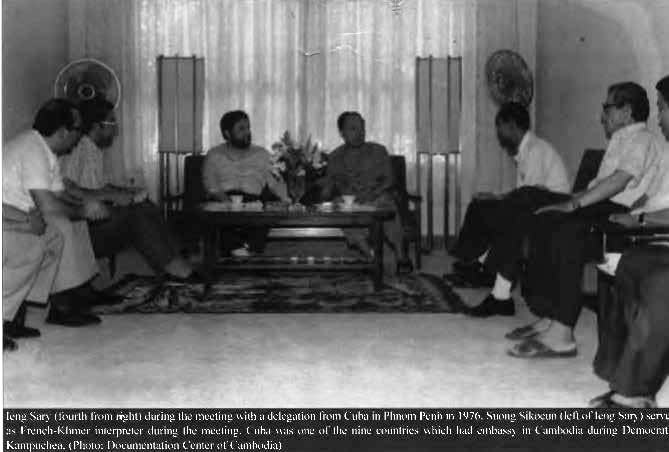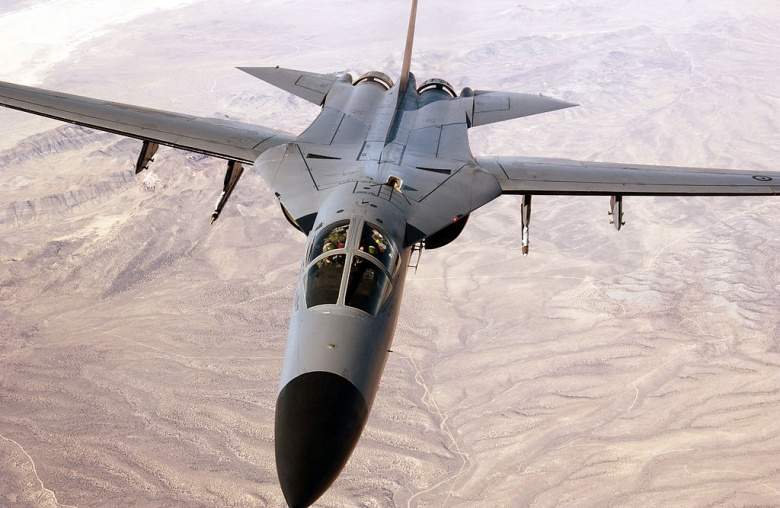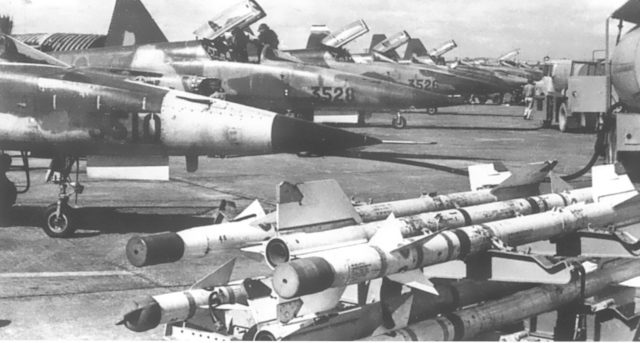In late February 1976, Siem Reap town was rocked by a series of devastating explosions.
Days later, Deputy Prime Minister of Democratic Kampuchea led an international delegation of diplomats from Sweden, North Korea, South Vietnam (the Republic had not yet been formed), Cuba, Zambia, Afghanistan, Albania, China, Egypt, North Vietnam, Tunisia and Yugoslavia- along with a representative of the Palestine Liberation Organization to survey the damage.

Most were shipped in on one of the twice-monthly flights from Beijing (Peking) to Phnom Penh in order to give credibility the Khmer Rouge claims of bombing of Cambodian territory.
The Cambodian government blamed ‘American imperialist aircraft’ for the attack, in which it claimed 15 people had been killed with 40 wounded, destroyed 29 houses, partly destroyed a hospital and damage to 366 buildings.
The international delegates confirmed they bore witness to destruction of the town, but were unable to verify the cause. The Zambian Ambassador to China, Andreya Sylvester Masiye, later confirmed his words had been misrepresented in a Radio Phnom Penh broadcast.
All confirmed seeing the evidence, which was presented to them by Ieng Sary. “Something has happened in Siem Reap, but I don’t know what and I don’t know when” said Kaj Bjork, the Swedish Ambassador in China, who was part of the sanctioned visit- and the first westerner permitted into Democratic Kampuchea since 1975. “Local officials have come to the conclusion that the bombardment was carried out by an American aircraft,” Mr. Bjork said after his return to China. The New York Times reported that he did not consider himself a good judge of what happened because he had no experience of war.
An American cable, published by Wikileaks explains:
BJORK SAID HE SAW A CRATER AND VARIOUS OTHER SIGNS OF DESTRUCTION IN THE TOWN AND WAS TOLD THAT 15 PERSONS DIED IN THE BOMBING. THE RESIDENTS REPORTED FINDING FOREIGN PLANES BUT COULDN’T MAKE OUT THE MARKINGS, BJORK SAID. HOWEVER, AFTER INVESTIGATION, “THEY HAD COME TO THE CONCLUSION THAT THE ONLY ONES WHO COULD HAVE DONE THIS WERE THE ‘AMERICAN IMPERIALISTS'”.
5. ASKED WHETHER THE DESTRUCTION COULD HAVE BEEN CAUSED BY EXPLOSION OF A MUNITIONS DUMP OR BY SIMILAR ACCIDENT, BJORK SAID HE PREFERRED NOT TO MAKE ANY FURTHER COMMENTS. HE SAID CAMBODIA STILL PORTRAYS THE UNITED STATES AS A THREAT: “THERE IS A LOT OF TALK ABOUT AMERICAN IMPERIALISM…BARBAROUS, FEROCIOUS …ALL SORTS OF EPITHETS.”
The Americans denied any involvement, with other Western observers of the region suggesting that the Khmer Rouge government staged the incident for propaganda purposes- while others have suggested that Vietnamese or Thai aircraft were behind the attack.
The Democratic Kampuchea Version
The best English source for the Khmer Rouge government’s version of events was written by American Marxist journalists and published in The Call in 1978– two years after the incident.
The delegation- the first Americans allowed into the country since 1975- headed by American Communist Daniel Burstein (ironically now a venture capitalist) arrived on April 28, 1978, and were treated as guests of honor by Ieng Sary.

They reported what their Cambodian minders had told them, with all the naivety of the radical 1970’s left:
“Siem Reap, located in the northwest part of Kampuchea between Lake Tonle Sap and the Thai border, was the site of a vicious bombing raid carried out by U.S. Air Force F-111 jets on February 25, 1976 (*in 1976 Phnom Penh Radio first claimed F‐3’s were responsible, but changed quickly to F-111’s- then dropped all mention of the type). This was more than ten months after the war had supposedly ended.
The incident of unprovoked U.S. aggression against sovereign, independent, peaceful Kampuchea is one that has been almost totally covered up in this country. But we learned the facts about it right on the spot.
Standing in the midst of the rubble that had once been the center of Siem Reap, our Kampuchean guide Comrade So told us. “It was the morning of Feb. 25, about 8:30. There was a school here, and the children had already arrived. Suddenly the sky lit up and the shrieking thunder of bombing could be heard. The school had been hit and it was going up in flames.”
The high-flying F-111 dropped three bombs altogether on the central part of Siem Reap. The first bomb, weighing over 1,000 pounds, made a huge crater more than seven yards deep and ten yards in diameter. Two more bombs exploded before the F-111 veered off for Thailand.
Later that day, around 2 P.M., two more F-111s buzzed overhead, again dropping a series of blast-bombs on the same place.
“Twelve children were killed,” said Comrade So, pointing to where the school had stood. “altogether about 15 people were killed and 30 insured.”
We walked over to inspect the sight. The schoolhouse had been reduced to a large pile of cement blocks, with burnt and rusted pieces of aluminum and other metals jutting out from it. Comrade So warned us to be careful, because some undetonated explosive charges might still be buried in the rubble.
Across from the school there had been a childcare center, but it was totally wiped out, leaving only the deep crater. Looking at the evidence of the powerful impact, we imagined what it must have been like that day in 1976 when U.S. planes screamed overhead and a peaceful Kampuchean schoolyard was turned into a nightmarish scene.
It was not hard to picture the expressions on the faces of the people and the commotion that must have ensued. Nor was it difficult to imagine the anger of the townspeople once all the evidence about what had happened was put together.
“It was nothing but air piracy,” said Comrade So. “The bombing of Siem Reap showed us that the U.S. would not resign itself to its defeat in Kampuchea. Like the Mayaquez affair, the bombing of Siem Reap was an aggressive and destructive act against our revolution.”
Comrade So’s reference to the Mayaguez affair reminded us of the details of that incident in May 1975. At that time, U.S. President Ford ordered an attack on a Kampuchean island supposedly to “defend American lives” after the ship Maya-guez had been captured for intruding in Kampuchean waters. Later revelations, however, showed that Ford knew full well that the American sailors were not being held on the island and the attack that he ordered was nothing but an act of aggression designed to bully newly-liberated Kampuchea.
We asked Comrade So why he thought the particular time and place of the Siem Reap bombing was chosen. He explained that there were several factors involved, notably that Samdech Norodom Sihanouk, the former prince and national leader of Kampuchea, was visiting Siem Reap that day. This indicated that the enemy either sought to kill Sihanouk or create an incident that would split the country’s unity.
Comrade So also explained to us that external acts of aggression emanating either from the U.S. or from Vietnam have been repeatedly used to create eon-fusion and give reactionary agents inside the country opportunities to incite conflicts and even to attempt coup d’etats.
The day after the bombing of Siem Reap, Democratic Kampuchea issued a formal statement exposing the facts of the incident and condemning U.S. imperialism for its aggression. The statement was circulated at the United Nations.
In reply, the U.S. government issued a one paragraph note -the only official statement it has ever published about the incident–in which it made a “categorical rejection” of Kampuchea’s charges and said that they were “completely without foundation.”
This self-confident denial disappeared recently, however, when U.S. State Dept. official Tim Carney (later Director of Information and Educationfor UNTAC) admitted in a discussion with a Call journalist, “We don’t really know what happened at Siem Reap. They were our planes, all right, but how they got there I don’t know.”
Obviously, the U.S. has much to hide about its role in the bombing of Siem Reap. And Siem Reap is only the tip of the iceberg. As recently as this year there have been several attempted coup d’etats fomented by Kampucheans in the pay of the CIA, as well as many other instances of U.S.-instigated aggression and subversion in Kampuchea.”

The Americans
Okay, let’s look at this. For a start the account, given what is now known about the Khmer Rouge regime is patently false- school, childcare?
The F-3 was retired from service in 1964. It most likely refers to the F-3D ‘Skyknight’, which saw limited service in the Korean War, but was redesignated as the F-10 in 1962, and was also withdrawn from service in 1970. Neither were used by any other military than the USAF. There was no way that this aircraft could have attacked anywhere 900 km away from a USAF museum.
Meanwhile, the F-111 was, at the time, one of the most technically advanced aircraft of the day. Only the Americans and Australians operated them. The aircraft would have been known to the Khmer Rouge as, F-111As of the 347th Tactical Fighter Wing (347th TFW) were stationed in Thailand (first at Takhli Air Base and later at Korat). The 347th TFW conducted bombing missions in Cambodia in support of Khmer Republic forces until 15 August 1973 when US combat support ceased in accordance with the Case–Church Amendment. 347th TFW F-111s provided air support during the Mayaguez incident in May 1975.
After the news broke that Thai bases (including F-111’s from Korat) were used to support the Mayaguez rescue the Thai Government lodged a formal protest with the US and riots broke out outside the US Embassy in Bangkok. The US agreed to the Thai government demands to leave the country by the end of 1975. The USAF implemented Palace Lightning, to withdraw its aircraft and personnel from Thailand.
On 30 June 1975, the USAF were taken out of Thailand. The F-111s were sent to the 422d Fighter Weapons Squadron at Nellis Air Force Base, Nevada. Even if there were F-111’s in Southeast Asia, the nearest bases to Cambodia were in The Philippines- not only out of range, but would have involved flying over Vietnam, or Laos- a risky venture just to drop a few bombs on the insignificant target of Siem Reap. Although originally a dual Navy-Air Force aircraft, the plane was not used on US carriers.
So, there were no F-111s anywhere near Cambodia at the time, but were known to have been in Thailand in the months before, and recognized by the Khmer Rouge as an effective aircraft- so was almost certainly used as a convenient scapegoat.

One of the 1976 delegates, Zambian Ambassador was given a dressing down by the US Ambassador on his return to Beijing (WIKILEAKS):
MASIYE FIRST RESPONDED FLATLY THAT HE HAD ONLY EXPRESSED REACTION TO GREAT DESTRUCTION WHICH OBVIOUSLY HAD FRESHLY TAKEN PLACE, BUT HAD NOT RPT NOT LINKED DESTRUCTION TO UNITED STATES. HE NOTED THAT HE HAD SEEN NO DIRECT EVIDENCE TO SUPPORT SUCH A CHARGE AND THAT HIS MILITARY EXPERIENCE HAD TAUGHT HIM HOW DIFFICULT IT IS TO IDENTIFY TYPES OF AIRCRAFT, DESPITE WHAT HIS CAMBODIAN BRIEFER HAD SAID. HE ASKED THAT I RE-READ RADIO PHNOM PENH’S VERSION OF HIS REFERENCE TO TME US, AND THEN SAID, FIRST, ACCURACY COULD EASILY HAVE BEEN LOST IN CAMBODIANBAFRENCH-ENGLISH INTERPRE- TATION AND, SECOND, HE DID NOT HAVE COMPLETELY FIRM RECOLLECTION OF WHAT HE HAD SAID, BUT COULD NOT BE RESPONSIBLE FOR CAMBODIAN VERSION. HE REQUESTED THAT I OBTAIN FOR HIM TAPERECORDED VERSION OF RADIO PHNOM PENH’S BROADCAST, I TOLD HIM I WOULD BE GLAD TO ATTEMPT TO DO SO BUT STRESSED OUR INTEREST IN FIRMLY REGISTERING FACT THAT US HAD NOTHING TO DO WITH FEBRUARY 25 SIEM REAP INCIDENT. HE PROMISED TO SO REPORT.
The Vietnamese
After the fall of Saigon, the new regime acquired almost 900 American made aircraft- including 41 F-5s and 95 A-37s. The Vietnamese Air Force also had various Soviet MiG fighters- none of these could be confused with F-111s.
The relationship between Vietnam and Democratic Kampuchea soured quickly. Just two days after the fall of Phnom Penh the Vietnamese island of Phu Quoc (known as Koh Tral to Cambodians), 15 km off the coast of Kampot, was shelled by forces under the command of Ta Mok’s son-in-law Khe Muth.
Early in May 1975 a Khmer Rouge raiding party briefly held parts of the island, reportedly raising the plain red flag of revolution on the beach. The Provisional Revolutionary Government of South Vietnam (the country would not officially unify for over a year after the fall of Saigon) sent helicopters to strafe the beach. The Cambodians were finally forced off when a contingent of North Vietnamese Army troops arrived to clear them from the island.
On May 10, 1975, Khmer Rouge forces occupied Thổ Chu Island, 120 km south of Phu Quoc and took around five hundred Vietnamese civilians to Cambodia where they were all killed. From May 24 to May 27, 1975, Vietnamese forces attacked and recaptured the island. However, in 1976 (date unknown) Democratic Kampuchea dropped all claims to the islands controlled by Vietnam.
Did the Vietnamese, possibly using American made aircraft such as an F-5, attack the town in order to teach the Khmer Rouge a lesson?
Maybe, but according to The New York Times:
South Vietnam’s Ambassador, Pham Van Ba, was quoted by Phnom Penh Radio as having said, “We have seen with our own eyes the very savage aggression committed on Feb. 25 by the American imperialists against Cambodia.”
Pretty duplicitous behavior, if he knew his own country had done the deed. And why Siem Reap? There were dozens of targets closer to the Vietnamese border that didn’t involve flying so far, risking an embarrassing international incident if things went wrong- such as accidently straying into Thai airspace.
An attack on Cambodia would also have worsened relations between Beijing and the Vietnams, which were in the process of unification.

The Cambodians
A much more likely explanation for the explosions comes on the ground- either as an accident that was exploited for political gain, or a deliberate act designed to create sympathy (and aid) to the new regime.
1976 was a pivotal year for Democratic Kampuchea. After evacuating the cities in 1975- by claiming US bombing was imminent- the new nation was proclaimed on January 5.
In February 1976, just one week before the explosions, French Newspaper Le Monde began publishing articles about the atrocities being committed by the new regime, going as far to say that 800,000 had been killed ‘Le Cambodge neuf mois après?’ by François Ponchaud. This began great debate in the country- which has a history of radical-left movements and anti-imperialism- with leftist newspapers such as Libération denouncing the claims as CIA propaganda.
Never far away from modern Cambodian intrigue, Sihanouk- then the Head of State was supposedly visiting Siem Reap at the time of the explosions. He was certainly on a tour of the countryside with Khieu Samphan during that month, and reportedly resigned his role after witnessing the conditions of the people and the forced labor practices in place. This resignation was not recognized until April- perhaps the explosions and bombing story was a last-ditch attempt to persuade the prince to remain in the fold.
There is always a chance that the explosions were caused by a dissident faction within Cambodia- either Communists against the domination of Pol Pot-Ieng Sary, or remnants of Lon Nol’s forces- although the latter is very unlikely. A Khmer Rouge leader Koy Thuon- aka Touch- was later executed after a sub-ordinate named Chan Chakrei confessed- after 3 months in Toul Sleng- to similar explosions which took place in April 1976.
Whatever caused the explosions in Siem Reap remains a mystery. The results had the desired effect- although barely making a ripple in the western press (with the exception of radical-left news and the New York Times), the event was well-publicized in the Eastern Bloc. Chinese military aid began pouring in to Democratic Kampuchea from 1976, which was later used- to disastrous effect on Vietnam in the years that followed.
If anyone knows more- there may even be some surviving witnesses- please get in touch. HISTORY STEVE

Interesting article. I interviewed the Swedish diplomates that visited Siemreap. They were convinced that the “bombing” had been staged by the KR. In fact they took a sample with them of the earth and stones, send for testing in Sweden and the result was that it was the outcome of a very old bombing not a new one.